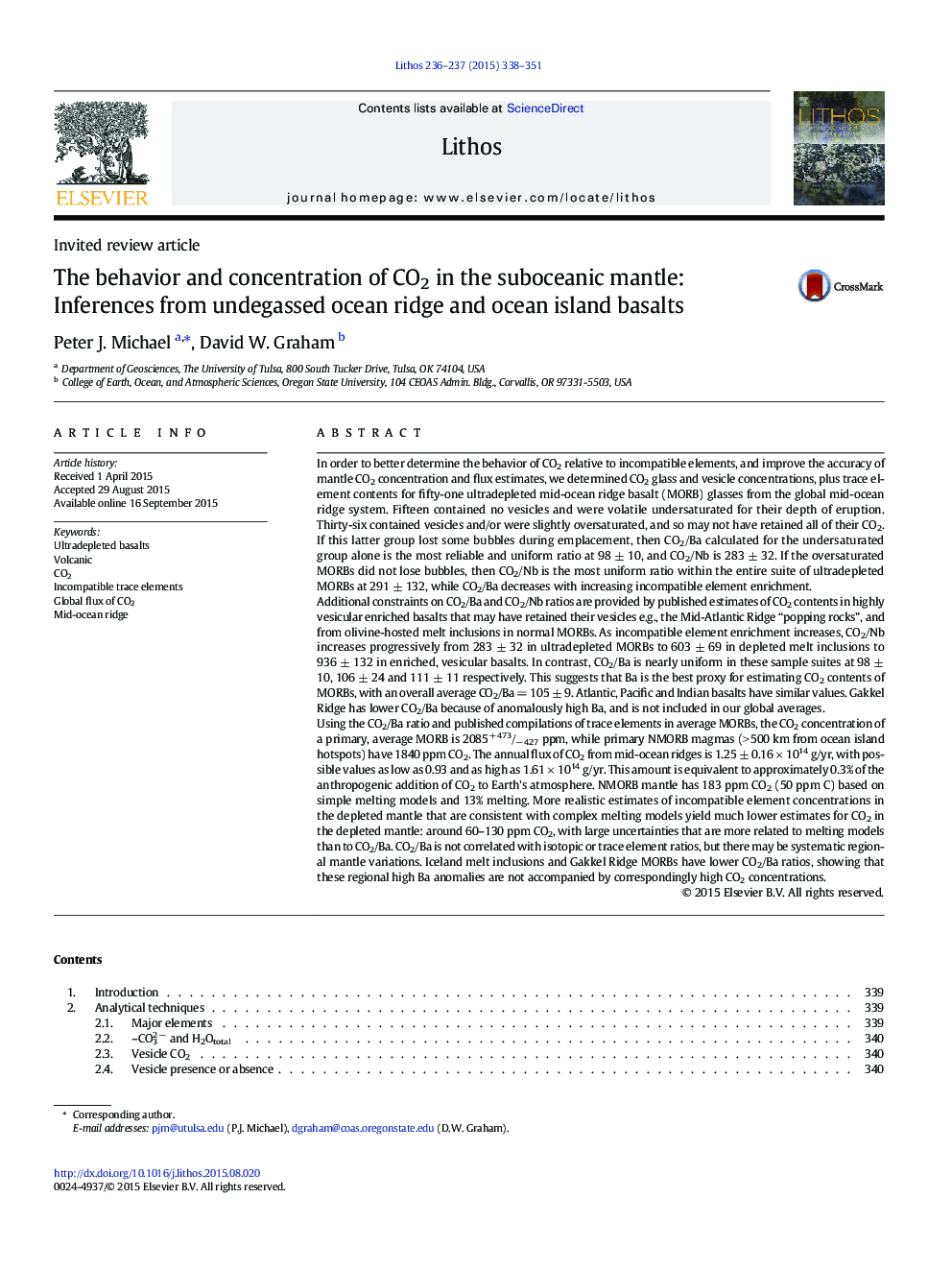| کد مقاله | کد نشریه | سال انتشار | مقاله انگلیسی | نسخه تمام متن |
|---|---|---|---|---|
| 4715593 | 1638656 | 2015 | 14 صفحه PDF | دانلود رایگان |

• Ocean ridge basalts that erupt undersaturated in CO2 have uniform CO2/Nb or CO2/Ba.
• For ultradepleted through enriched mid-ocean ridge basalts, CO2/Ba = 105 ± 9.
• CO2 is one of the most incompatible elements during mantle melting, behaving like Ba.
• CO2 flux from mid-ocean ridges calculated with the CO2/Ba ratio is 1.25 × 1014 g/year.
• Calculated mantle CO2 content depends more on melt models than on the CO2/Ba ratio.
In order to better determine the behavior of CO2 relative to incompatible elements, and improve the accuracy of mantle CO2 concentration and flux estimates, we determined CO2 glass and vesicle concentrations, plus trace element contents for fifty-one ultradepleted mid-ocean ridge basalt (MORB) glasses from the global mid-ocean ridge system. Fifteen contained no vesicles and were volatile undersaturated for their depth of eruption. Thirty-six contained vesicles and/or were slightly oversaturated, and so may not have retained all of their CO2. If this latter group lost some bubbles during emplacement, then CO2/Ba calculated for the undersaturated group alone is the most reliable and uniform ratio at 98 ± 10, and CO2/Nb is 283 ± 32. If the oversaturated MORBs did not lose bubbles, then CO2/Nb is the most uniform ratio within the entire suite of ultradepleted MORBs at 291 ± 132, while CO2/Ba decreases with increasing incompatible element enrichment.Additional constraints on CO2/Ba and CO2/Nb ratios are provided by published estimates of CO2 contents in highly vesicular enriched basalts that may have retained their vesicles e.g., the Mid-Atlantic Ridge “popping rocks”, and from olivine-hosted melt inclusions in normal MORBs. As incompatible element enrichment increases, CO2/Nb increases progressively from 283 ± 32 in ultradepleted MORBs to 603 ± 69 in depleted melt inclusions to 936 ± 132 in enriched, vesicular basalts. In contrast, CO2/Ba is nearly uniform in these sample suites at 98 ± 10, 106 ± 24 and 111 ± 11 respectively. This suggests that Ba is the best proxy for estimating CO2 contents of MORBs, with an overall average CO2/Ba = 105 ± 9. Atlantic, Pacific and Indian basalts have similar values. Gakkel Ridge has lower CO2/Ba because of anomalously high Ba, and is not included in our global averages.Using the CO2/Ba ratio and published compilations of trace elements in average MORBs, the CO2 concentration of a primary, average MORB is 2085+ 473/− 427 ppm, while primary NMORB magmas (> 500 km from ocean island hotspots) have 1840 ppm CO2. The annual flux of CO2 from mid-ocean ridges is 1.25 ± 0.16 × 1014 g/yr, with possible values as low as 0.93 and as high as 1.61 × 1014 g/yr. This amount is equivalent to approximately 0.3% of the anthropogenic addition of CO2 to Earth's atmosphere. NMORB mantle has 183 ppm CO2 (50 ppm C) based on simple melting models and 13% melting. More realistic estimates of incompatible element concentrations in the depleted mantle that are consistent with complex melting models yield much lower estimates for CO2 in the depleted mantle: around 60–130 ppm CO2, with large uncertainties that are more related to melting models than to CO2/Ba. CO2/Ba is not correlated with isotopic or trace element ratios, but there may be systematic regional mantle variations. Iceland melt inclusions and Gakkel Ridge MORBs have lower CO2/Ba ratios, showing that these regional high Ba anomalies are not accompanied by correspondingly high CO2 concentrations.
Journal: Lithos - Volumes 236–237, November 2015, Pages 338–351